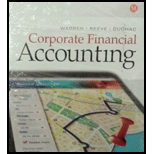
A.
Earnings per share:
Earnings per share represent the amount of income earned per share of outstanding common stock in a period. This ratio is used for analyzing the profitability of company’s stockholders’.
The following formula can be used to calculate earnings per share:
To compute: Earnings per share of Incorporation A and company W.
B.
To identify: The company which appears to be more profitable on the basis of earnings per share.
C.
To explain: The possible reasons behind the differences between the Incorporation A and Company W’s market price per share and earnings price per share.
Want to see the full answer?
Check out a sample textbook solution
Chapter 12 Solutions
Bundle: Corporate Financial Accounting, Loose-leaf Version, 14th + LMS Integrated for CengageNOWv2, 1 term Printed Access Card
- Internal control refers to the processes and procedures implemented by an organization to ensure the integrity of financial and accounting information, promote accountability, and prevent fraud. These controls are designed to provide reasonable assurance that the organization achieves its objectives in operational efficiency, financial reporting reliability, and compliance with laws and regulations. Internal control is a comprehensive system that includes a variety of checks and balances, such as segregation of duties, authorization and approval processes, reconciliations, and physical security measures. It is an integral part of an organization's governance framework, helping to safeguard assets, improve operational efficiency, and ensure accurate and timely financial reporting. Respond to the above postarrow_forwardI need the correct answer to this general accounting problem using the standard accounting approach.arrow_forwardYou are a team of accounting consultants hired by the company VinGrenDom Ltd., a regional utility and manufacturing firm expanding into the Eastern Caribbean. The Board of Directors is requesting an accounting report that addresses three critical areas in their financial statements. Part A: Working Capital 1. Define working capital and explain its importance in financial health and liquidity management. 2. Assess how the matching concept and accrual basis affect the reporting of current assets and liabilities. 3. Using a hypothetical balance sheet (you may create one), identify at least 5 current assets and 5 current liabilities and analyze how changes in these elements affect liquidity ratios. 4. Recommend at least two strategies VinGrenDom Ltd. can implement to optimize working capital.arrow_forward
 Financial And Managerial AccountingAccountingISBN:9781337902663Author:WARREN, Carl S.Publisher:Cengage Learning,
Financial And Managerial AccountingAccountingISBN:9781337902663Author:WARREN, Carl S.Publisher:Cengage Learning, Financial Accounting: The Impact on Decision Make...AccountingISBN:9781305654174Author:Gary A. Porter, Curtis L. NortonPublisher:Cengage Learning
Financial Accounting: The Impact on Decision Make...AccountingISBN:9781305654174Author:Gary A. Porter, Curtis L. NortonPublisher:Cengage Learning Cornerstones of Financial AccountingAccountingISBN:9781337690881Author:Jay Rich, Jeff JonesPublisher:Cengage Learning
Cornerstones of Financial AccountingAccountingISBN:9781337690881Author:Jay Rich, Jeff JonesPublisher:Cengage Learning Managerial AccountingAccountingISBN:9781337912020Author:Carl Warren, Ph.d. Cma William B. TaylerPublisher:South-Western College Pub
Managerial AccountingAccountingISBN:9781337912020Author:Carl Warren, Ph.d. Cma William B. TaylerPublisher:South-Western College Pub Financial AccountingAccountingISBN:9781337272124Author:Carl Warren, James M. Reeve, Jonathan DuchacPublisher:Cengage Learning
Financial AccountingAccountingISBN:9781337272124Author:Carl Warren, James M. Reeve, Jonathan DuchacPublisher:Cengage Learning Financial AccountingAccountingISBN:9781305088436Author:Carl Warren, Jim Reeve, Jonathan DuchacPublisher:Cengage Learning
Financial AccountingAccountingISBN:9781305088436Author:Carl Warren, Jim Reeve, Jonathan DuchacPublisher:Cengage Learning





